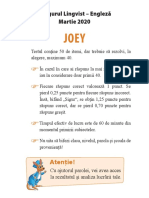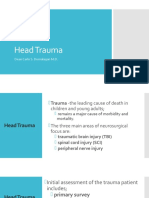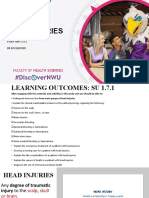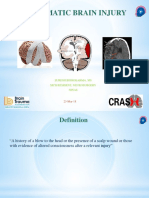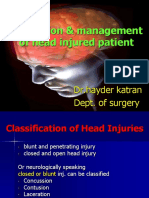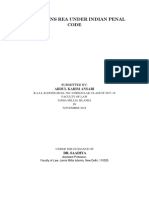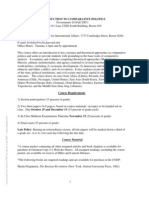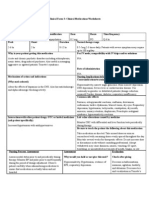NCM118 Transes
NCM118 Transes
Uploaded by
Alejandro Saclolo, IIICopyright:
Available Formats
NCM118 Transes
NCM118 Transes
Uploaded by
Alejandro Saclolo, IIIOriginal Title
Copyright
Available Formats
Share this document
Did you find this document useful?
Is this content inappropriate?
Copyright:
Available Formats
NCM118 Transes
NCM118 Transes
Uploaded by
Alejandro Saclolo, IIICopyright:
Available Formats
NCM 118: EMERGENCY NURSING
MAJOR TRAUMA
st
ST. PAUL UNIVERSITY SURIGAO 1 SEMESTER A.Y. 2023 – 2024
-Ask pt. to squeeze their hands or raise their leg off the bed
HEAD AND NEUROLOGIC TRAUMA etc. simultaneous assessment of both sides of the pt. body,
where possible, is important..
Common forces involved: -The nurse should be aware of abnormal posturing which
Blunt acceleration forces- injury by forceful impact/ indicate serious hypoxic brain injury.
struck by a dull object. Decorticate/flexion (where pt arms are drawn rigidly
Deceleration forces- when head is moving and strike up against their chest.
a stationary object. Decebrate / extension (where the pt. arms turn
Penetrating forces- object enters the head rigidly outwards against their sides of the body)
MISSED INJURIES ASSESMENT OF LEVEL OF VITAL SIGNS
Secondary neurologic injuries ( to the brain and brainstem) (Serious brain injury)
complications often develop slowly, sometimes even Hypertension (compensatory mechanism foo maintain
hrs or days after the initial trauma was sustained cerebral blood flow)
w/ subtle and non-specific signs cardiac dysrhythmia ( due to brainstem dysfunction)
hyperthermia (as cerebral dysfunction a metabolism
TWO FUNDAMENTAL GOALS FOR increases)
NEUROLOGIC ASSESMENT A pt. / a severe late brain injury where there is significant
To identify any obvious signs of head trauma and pressure will often on the brainstem, determine demonstrates
underlying neurological injury signs known as Cushing’s triad
To provide baseline data which can be used to 1. Hypertension
identify developing neurologic injury 2. widening pulse pressure
3. Brady Cardia
NEUROLOGIC ASSESMENTS OF A PT. WITH
SUSPECTED OR ACTUAL HEAD TRAUMA
ASSESMENT OF LEVEL OF CONCIOUSNESS
-Using Glassgow Coma Scale
-assesses the functioning of a pt. CNS via their response to
verbal and/or painful stimuli
-when assessing the pt’s LOC, intoxication, sleepiness can
result to an inaccurate score
A COMPUTERIZED TOMOGRAPHY SCAN
ASSESSMENT OF PUPILLAR SIZE, EQUALITY AND
REACTIVITY TO LIGHT(using pen-torch) The National of the head Institute of Heath and Clinical
Excellence’s Head
-PERRLA = Pupils Equal, Round, Reactive to Light and
Injury : Assessment & Early Management CG176) Guideline
Accomodation
-a CT scan be undertaken if a pt. has a GCS of 13 on initial
-problems with PERRLA are often the first signs of an
presentation or a GCS of <15 2hrs after the injury
increased ICP due to, for example, an intracranial hemorrhage
suspected skull fracture
or edema of the soft tissues of the brain.
A post-traumatic seizure
Any focal neurological deficit
ASSESMENT OF LEVEL OF CRANIAL NERVES
more than 1 time vomiting.
-CN III (oculomotor), CN IV (trochlear), CN VI (abducens)
- these nerves exit the spinal cord around the area of the brain
stem
COMMON HEAD INJURY AND
-rapidly assessed by asking the pt. to follow finger through six MANAGEMENT
directions ( Six Cardinal Gaze ), sign of neurologic injuriry are:
Disconjugate gaze= deviation of one eye
SCALP LACERATION
Ptosis = drooping of eyelids
-Scalp is highly vascularised & scalp laceration often bleed
ASSESMENT OF LEVEL OF MOTOR SYMMETRY AND profusely
STRENGHT -Typically managed by direct pressure to control initial
-If pt is conscious hemorrhage, and subsequent wound repair using sutures,
staples or dips.
Property of: Chesca Lian Edillor Almazan
NCM 118: EMERGENCY NURSING
MAJOR TRAUMA
st
ST. PAUL UNIVERSITY SURIGAO 1 SEMESTER A.Y. 2023 – 2024
SKULL FRACTURE ✓ temporary amnesia
✓ minor confusion & disorientation
Linear (the fracture is non-displaced, and there is no
minor neurological damage) ✓ headache
depressed (one side of the fracture displaces below ✓ dizziness
the other, and there is moderate to severe neurologic ✓ drowsiness
damage ) ✓ irritability
Signs of suspected skull fracture ✓ visual disturbances
✓ hemotympanum (leakage of blood in ears)
✓ Raccoon eyes Care for pt with consussion involves regular observation to
✓ Leakage of CFS from ear or nose identify more serious brain injury and symptomatic
✓ Battle’s sign (bruising behind the ears) mastoid area management.
Linear usually only requires supportive care
Depressed = usually require surgical repair (plating)
DIFFUSED AXONAL INJURY
CONTUSION -a sever traumatic brain injury that results in shearing of the
-a bruise of on the scalp or on the surface of the brain arons, key structures w/in white matter of the brain
-When acceleration-deceleration forces are involved in the
injury, two contusions on the surface of the brain may result. Pt. w/ DAI typically present w/
Coup = the initial site of impact ✓ extended loss of consciousness
Contrecoup = the opposite side of the brain, as it ✓ flexion or extension posturing
rebounds inside the skull ✓ dysfunction of the autonomic nervous system
Pts w/ contusion are typically present with Management of pt with DAI involves supportive care, however
✓ an altered LOC their prognosis is often poor with patient rarely returning to their
✓nausea and/or vomiting full pre-injury neurologic function.
✓ visual disturbances
INCREASED INTRACRANIAL PRESSURE
✓ weakness
✓ difficulties w/ their speech Causes:
-Most contusions only require supportive care; however, cerebral edema
severe contusions may require. Surgical evacuation, and the Increased cerebral blood flow (e.g. hemorrhage)
removal flap of a of bone to relieve ICP whilst the brain tissue
heals. Pt. w/ ICP present w/
✓ decreased LOC
SUBDURAL OR EPIDURAL HEMATOMA ✓ changes in Vs (CT)
(bleeding beneath OR between the skull & one of the layers of ✓ pupillary dilation
the dura mater arachnoid matter) ✓ severe headache.
Pts w/ hematoma often present with ✓ nausea / vomiting.
severe headache ✓ decrease in motor function
Pupillary dilation on the same side of the body w/c
sustained the traumatic injury - Where ICP is very high, pressure in the brain stem may result
hemiparesis (One sided weakness) on the opposite in brain death, where brain fx completely and irreversibly
side ceases
Small hematoma usually only require supportive care, through -Management of increased ICP involves managing its
larger ones may require surgical evacuation (craniotomy). underlying causes; medication & surgical therapy may be used.
CONCUSSION Focus Tx on:
Treating the greatest threat to life first (management
(mild traumatic brain injury that involves a loss of
of airway, breathing & circulation)
consciousness w/ associated disruptions to neurological
functioning) Effective managing pt pain (use small venous opioid)
but frequent doses
Presentations
✓nausea/ vomiting
✓visual disturbances
Property of: Chesca Lian Edillor Almazan
NCM 118: EMERGENCY NURSING
MAJOR TRAUMA
st
ST. PAUL UNIVERSITY SURIGAO 1 SEMESTER A.Y. 2023 – 2024
ORTHOPEDIC TRAUMA CLOSED (Bone is broken but skin is intact)
OPEN COMPOUND (where the bone is open and
Bones, surrounding soft tissue and associated neurovascular protrudes through skin
structures including nerves and blood vessels. ECCHYMOSIS - Bleeding w/ bruising
Common mechanism that causes orthopedic injuries: Patient Presents with
✓ Road Traffic Accidents Obvious Deformity (x-ray)
✓ Falls From height Pain
✓ Assaults Swelling
✓ Sports & recreation Ecchymosis in the affected region
Complications
✓ General accidents
Broken bones may lacerate vital organs /arteries/
nerves
Orthopedic Injuries involving long bones may which may result
Fractures of the large bones may result in
in hemorrhage, shock and severe pain may require immediate
hemorrhage
care.
MANAGEMENT
ASSESSMENT OF TRAUMATIC
ORTHOPEDIC INJURIES ✓Immobilization of the Fracture
-Assess ABC Traction splint or an adjacent leg splint for fracture of
-Assess musculoskeletal system the femur
Vacuum splint for all other long bone fractures.
1. Examine trauma site/s for obvious signs of injury. Temporary casts may also be used
✓Obvious deformity ✓Minor fractures may be reduced (realigned) and fixed in the
✓Laceration emergency care setting
✓ Contusion ✓ More severe fractures require surgical intervention
✓Edema
DISLOCATIONS
✓ Abrasions
Occurs when a joint exceeds its normal ROM & the joint
✓ Pain
surfaces become disconnected
2. Do a Focused neurovascular assessment
✓ Colour SUBLUXATION - Term used to describe a dislocation if there
✓ Temperature is only partial or incomplete displacement of the joint surfaces.
✓ Pulses
✓ Sensation Common points of dislocation
✓ Motor function in the affected limbs Shoulder, Elbow, Finger, hip, knee / Patella, ankle & toe
Patients usually present with
INJURY RELATED TO ORTHOPEDIC
Obvious deformity (confirmed by x-ray)
TRAUMA AND MANAGEMENT IN THE Pain & Swelling
EMERGENCY CARE SETTING Ecchymosis
SPRAIN AND STRAIN Minor Dislocation may be corrected in Emergency care setting
Involve minor damage to muscle, usually at its point OF via manipulation
attachment to a tendon Severe Dislocation require surgical intervention
Doesn’t require urgent care
Encourage to TRAUMATIC AMPUTATION
Support Removal of all or part of a digit, limb or other body structure
Ice such as foot, hand, ear, nose, etc.
Elevate affected Limb
Manage Pain Using Oral Analgesia (Paracetamol & Management
Ibuprofen) ✓Irrigating with normal saline
Avoid weight bearing for 24-72 hours ✓Moist dressing
✓Elevation and prophylactic antibiotic administration
FRACTURES
-Any disruption or break in the bone
Property of: Chesca Lian Edillor Almazan
NCM 118: EMERGENCY NURSING
MAJOR TRAUMA
st
ST. PAUL UNIVERSITY SURIGAO 1 SEMESTER A.Y. 2023 – 2024
LIMB REPLANTATION - Until the wound is closed the area will be wrapped in a
A complex microsurgical procedure that allows patients to have dressing. The wound will be monitored & will visit OR
severe limbs reattached
- Hours after trauma ✓ the dressing removed.
- Not guaranteed ✓Dead tissue removed.
✓the wound cleaned
MUSCLE INJURIES
✓ Stitches tightened slowly close area down
-Including injuries to the rotator cuff (muscles in the shoulder)
✓New dressing applied
and meniscus (fibrocartilage in the knee)
Closure may take up to 2 weeks and skin graft may be needed
Patient should
Key to the emergency management of traumatic orthopedic
✓ Support & Ice
injury
✓ Use Oral Analgesia
✓ Management of patient's pain
✓ Avoid Use 24 to 72 hours
✓ Immobilization
CRUSH INJURY
Occur when part of the body typically a digit or limb, is crushed
SPINAL TRAUMA
for a prolonged period.
Damage to the Spinal cord can do
Patient Present
Partial or complete paralysis
Necrosis
Blocs of motor ability
Symptoms of “SYSTEMIC CRUSH SYNDROME"
Loss of conscious function of body processes
1. Myoglubinuria
Life threatening CNS dysfunction (problems with
2. Acidosis (release lactic acid)
ABC)
3. Renal Failure - free myoglobin are too big to
the glomerulus, resulting to plugging of holes
Causes of spinal injury
4. Cardiac Disruption - release potassium
systemically. Road traffic accidents
Falls from height
Management: Supportive care if worst med-surg intervention Assault
Sports & recreation accidents
COMPARTMENT SYNDROME General accidents at work or in home
→ Occurs when excessive pressure builds up inside
→ usually develops bet 64 & hours after the primary Injury, Terms:
when the compartment pressure exceeds capillary pressure & Tetraplegia ¾ of the body
becomes clinically evident when compartment pressure
Quadriplegia four quadrants
exceeds venous pressure.
Paraplegia lover part of the body
Paralysis absence of sensation
5 P’s
Early signs
Spinal trauma assessment
PAIN
Assess ABC
PARESTHESIA (tingling sensation)
ASSESS OF THE SPINE & CNS
Late signs
Inspection & Palpation of the spine
PALLOR
Ask about pain & altered sensation in
PARALYSIS
regions of body
Last signs
Assess pt. conscious motor pan & reflexes
PUSELESSNESS imaging (x-rays & CT scans)
FASCIOTOMY
SPINAL INJURIES AND COMPLICATIONS
-A surgery to relieve swelling & pressure in a compart op the
body INCOMPLETE SPINAL CORD INJURY
-Tissue that surrounds the area is out open to relieve pressure Partial severing of spinal cord
- One incision will be made in the skin over the compartments Incomplete Spinal injury 7 will experience impairments
- Loose stitching will be placed over the area but the wound will There will always sensation of motor function below
remain open and will gradually close if swelling stops level of injury
NEUROGENIC SHOCK
Property of: Chesca Lian Edillor Almazan
NCM 118: EMERGENCY NURSING
MAJOR TRAUMA
st
ST. PAUL UNIVERSITY SURIGAO 1 SEMESTER A.Y. 2023 – 2024
Occurs when spinal injury is complete and motor HYPOVENTILATION
function bellow level of injury immediately ceases. Assessment of traumatic thoracic injuries
Irreversible Rate
Patients should learn and immobilization techniques Depth
to prevent further injury Effort of the patient's breathing
If injury is high it results problem with breathing Auscultate breath sounds
unable to maintain circulation & thermoregulate and it Integrity & symmetry of the chest wall
require emergency intervention Assessment of cardiac function & continuous
monitoring of cardiac rhythm
AUTONOMIC DYSREFLEXIA
Access patient circulation (capillary refill, skin color,
Complication of Spinal cord Injury which occurs above the level
temperature)
of 16 vertebrae
Imaging studies (x-rays or CT scans)
It leads to a massive, uncontrolled cardiovascular response
Can trigger such as full bladder or bowel and can occur any
time after onset of spinal injury INJURIES RELATED TO THORACIC TRAUMA
RIB FRACTURES
Patient presents with May involve a single or multiple ribs most occur in 4th 10th rib
Severe headache Management: Splinting
HTN
Bradycardia FLAIL INJURY
- A section of the rib cage independently from main ribcage
Anxiety
during breathing
Profuse sweating above & coldness below level of
- caused by severe rib fractures those involving eight or more
injury
ribs
Management: Splinting
Management of ABC & correction of the underlying causes are
crucial
PNEUMOTHORAX
- Accumulation of air in pleural space around the lungs
SECONDARY INJURIES TO THE SPINAL CORD
HEMOTHORAX - Blood fills in pleural space
Involvement of vertebral fractures
Management: THORACENTHESIS - Drainage of Fluid in
May develop over hours following initial injury
pleural space.
Manifestations
Patient typically presents with
Hemorrhage
Chest Pain
Edema
Dyspnea
Hypo perfusion of the spinal cord
Tachycardia
Endogenous biochemical response
Decreased or absence chest sounds.
Management of spinal injuries
Tracheal deviation away from the side of
Immobilization
pneumothorax
Cervical Spine Immobilization done by paramedics for
suspected or actual head injury. CARDIAC TAMPONADE
Spinal Board- used for patient with altered sensation - Occurs when there is accumulation of the blood in the
in their peripheries. pericardial sac.
Psychosocial care - Social Support BECKS TRIAD
1. Hypotension
2. Muffled (or indistinct) heart sounds
THORACIC TRAUMA 3. Distended neck veins
If untreated it results to increasing dyspnea, decreased LOC &
Any traumatic injury affecting chest area death
Causes Management: PERICARDIOCENTHESIS - To drain fluid
BUINT FORIES (Sudden deceleration, compression
or direct blows) MANAGEMENT OF TRAUMATIC THORACIC INJURIES
PENETRATING INJURIES Management with IV opioid analgesic
Patients with penetrating chest injuries tend to deteriorate more Administer high-plow oxygen via non- rebreather
rapidly & dramatically than those with blunt injuries mask
Two main problems associated potential thoracic injuries Reassurance
HYPOXEMIA
Property of: Chesca Lian Edillor Almazan
NCM 118: EMERGENCY NURSING
MAJOR TRAUMA
st
ST. PAUL UNIVERSITY SURIGAO 1 SEMESTER A.Y. 2023 – 2024
ABDOMINAL AND GENITOURINARY administration of supplemental oxygen (if airway
TRAUMA cannot be managed, sedation and insertion of an
TYPES: artificial airway may be required, usually
nasopharyngeal airway.
Injuries to the solid organs (kidney, spleen, pancreas
Inspection and subsequent palpation, following the
and liver)
administration of an appropriate level of analgesia of
Injuries to the hollow organs (stomach, bladder,
the facial bones (indicator of fraction)
intestines) Depressed irregularities in the bone
CAUSES
Crepitus
Penetrating forces Imaging studies such as X-rays or CT scans to
Falls from height formally diagnose internal injuries
Blunt force trauma If pt is conscious, ask about
Assaults Jaw pain
Road traffic accidents Ability to completely open jaw
Extent to which their teeth meet normally
COMMON INJURIES AND THEIR Assess visual acuity (count fingers)
MANAGEMENT Assess peripheral vision
Assess the facial nerve and its branches
LACERATION TO THE SOLID ORGANS Buccal nerve branch Wrinkle your nose
- liver and spleen are common sites of abdominal injuries. Mandibular nerve branch Purse your lips
- Liver injuries are significant because liver holds up to 25% of Temporal nerve branch Raise your eyebrow and
the body’s circulating blood at any given time, often resulting to wrinkle your forehead
major hemorrhage. Zygomatic nerve branch Squeeze your eye shut
Management: focus on maintaining hemodynamic stability
(aggressive fluid resuscitation) whilst preparing pt for corrective
COMMON MAXILLOFACIAL INJURIES AND
surgery.
MANAGEMENT
RENAL INJURIES
-majority are due to blunt force trauma SOFT TISSUES INJURY
Typical signs: - injuries to the skin, subcutaneous tissues, intraoral tissues,
Ecchymosis of the flanks eye and ear.
Palpable mass in the region of the kidney - although painful, these injuries do not usually require urgent
Hematuria (blood in urine) care, however hemorrhage may result.
Management: focus on the use of direct pressure to confront
BLADDER INJURIES initial hemorrhage, and subsequent wound repair
- most common site of genitourinary injury -sometimes, urgent ophthalmologic surgery may be provided to
- bladder injuries or usually associated with pelvic injury. save patient sight
Nonspecific signs
Gross hematuria FRACTURES
Pain in the suprapubic area the maxillary fracture
Difficulty voiding mandibular fracture
Abdominal tenderness the orbital region (eye socket)
- Only imaging studies can definitely diagnose a bladder injury Management:
Management: management of pain with opioid analgesic management of pain with opioid analgesic
administration of high flow oxygen via a non-
MAXILLO FACIAL rebreather mask
psychosocial care (changes in physical appearance
TRAUMA may cause distress)
- involves injury of the bones, neurovascular structures, skin,
subcutaneous tissues, muscles and glands of the face and
upper neck RESPIRATORY
- traumas are quite distinct, have the potential to cause EMERGENCIES
significant problems and appearance
ASSESSMENT
Ensure patency of the airway by checking possible
occlusion
displacement of the mandible
avulsed teeth
naso-orbital hemorrhage
swollen tongue
suction to remove foreign objects
control hemorrhage (by packing the nose and ASSESSMENT
applying ice across the cheeks Assessment of airway, breathing, circulation
A detailed assessment of pt’s respiratory system
Property of: Chesca Lian Edillor Almazan
NCM 118: EMERGENCY NURSING
MAJOR TRAUMA
st
ST. PAUL UNIVERSITY SURIGAO 1 SEMESTER A.Y. 2023 – 2024
Measure the RR with the aim of identifying Chest tightness
dyspnea Distress
Observe for other signs of dyspnea Treatment:
Pallor or cyanosis Administration of O2
Tripod positioning (leaning forward on the Inhalation of B2 agonist (vasodilator)
hands or elbows in attempt to open the Note: in severe cases, pt develop asthmaticus, a severe attack
chest) of asthma
Nasal flaring
Retractions
Accessory muscle use CHRONIC OBSTRUCTIVE
Grunting PULMONARY DISEASE
Difficulty speaking in complete sentences - a progressive and irreversible disease, often associated with
Tracheal tugging smoking
Auscultating the pt lungs, listen for adventitious lung Emphysema: enlargement of alveoli
sounds Bronchitis: inflammation of bronchioles
Rapid neurological assessment (GCS) S/SX
Rapid head-to-toe assessment (complication with the Severe dyspnea
respiratory system can have a variety of systemic
Production of purulent sputum
effects)
Pleuritic chest pain
Barrel chest due to hyperventilation of the
lungs Distress
Clubbing of fingernails (sign of chronic
hypoxia)
Chest X-ray or CT scan PULMONARY EMBOLISM
CBC - are blood clot or atherosclerotic plaque that occludes a large
ABG analysis vessel in the lungs
Non-specific symptoms
Comprehensive health history
Exposure to respiratory pathogen (influenza, Worsening Dypspnea
tuberculosis) Tachycardia
Respiratory hazards (asbestos, bird Cough
droppings, fumes, and dust) Diaphoresis
Smoking history Anxiety
DIAGNOSTICS
CT SCANS
ABG analysis
ECG
Ultrasonography
MOST COMMON RESPI CONDITIONS AND TREATMENT
MANAGEMENT Administration of Oxygen
Bronchodilator Corticosteroids
PNUEMONIA Anti-biotics
- an acute inflammation reaction in the lungs in response to the Ventilatory/ ventilation
presence of pathogen, often bacteria
Signs and symptoms INHALATION INJURY
Fever - Inhales substances produced by Fire ( asphyxiants: carbon
monoxide, smoke, drowning
Fatigue
CHERRY RED LIPS = carbon monoxide inhalation hallmark
Cough with hemoptysis
signs
Dyspnea Non-Specific Symptoms
Areas of consolidation
Dyspnea
Pleuritic chest pain
Coughing
Crackles
Gagging
Treatment: urgent, aggressive administration of broad
Choking
spectrum
Tachypnea
ASTHMA Pleuritic Chest pain
- Chronic obstructive disease of the lungs, characterized by Management
hyper-reactive inflammation and narrowing of the airways Bronchodilators for wheezing/ bronchospasm
Signs and symptoms: Epinephrine for stridor or retractions
Severe dyspnea
Coughing
Wheezing
Property of: Chesca Lian Edillor Almazan
NCM 118: EMERGENCY NURSING
MAJOR TRAUMA
st
ST. PAUL UNIVERSITY SURIGAO 1 SEMESTER A.Y. 2023 – 2024
ACUTE RESPIRATORY DISTRESS SYNDROME MYOCARDIAL INFARCTION (MI)
(ASRD) One of the arteries of the heart becomes occluded and the
Hypoxemic Respiratory Failure distal areas of the cardiac muscle become acutely hypoxic.
Oxygenation failure
Caused by imbalance between ventilation and Classification
perfusion ST-Segment MI (STEMI) - complete & prolonged
Severe cases where blood leaves the heart without occlusion of an epicardial coronary blood vessel &
having participated in gas exchange. defined based on ECG criteria
NON ST-segment MI (Non- STEMI) - severe coronary
Hypercapnic Respiratory Failure artery narrowing, transient occlusion or
Ventilation failure microembolization of thrombus and atherosclerotic
Imbalance between the supply of and demand for material
oxygen in the lungs Signs and symptoms
Management Chest or radiating pain
HIGH Flow o² via non-rebreather mask Fatigue
Blood Oxygen saturation (Sa 02) monitoring using Nausea
pulse oximeter Dyspnea
Psychosocial care of pain Diaphoresis
Dizziness
CARDIOVASCULAR Anxiety
EMERGENCIES WHAT TO DO WHEN SOMEBODY HAS HEART ATTACK
Mild, transient & Non- Specific Symptoms 1. Call 999/ 112 for emergency help (tell them you
suspect heart attack)
Without rapid intervention -> Late identification of illness 2. Tell them to sit down KNEES BENT
Poor management -> significant disability-> Death. 3. Give them aspirin 300 mg to chew
Assessment of a patient w/ cardiovascular illness DYSRHYTHMIA
Assess ABC An abnormality in the normal rhythm of the heart
Measure heart rate Categories
Quality of peripheral puises & BP
Signs of cardiac dysfunction - pallor and / or cyanosis, Tachycardia (HR > 100 bpm including atrial flutter,
diaphoresis & dyspnea atrial ventricular fibrillation, and long QT Syndrome
Ask feelings of dizziness, palpitations & nausea Bradycardia (HR < 60 bpm, often caused by a
Auscultate for adventitious heart sounds conduction block.
Assessment of chest pain Management: usually medications, but when cardiac arrest is
O-Onset imminent, a defibrillator shock may be used
P-Provocation & Palliation
Q-Quality PERICARDITIS
R- Region & Radiation - The fibrous sac surrounding the heart is inflamed due to
S- Severity infection.
T-Time - Pericarditis can lead to a range of significant complication,
Additional assessments to assist with Diagnosis including Mi & cardiac arrest
Chest X-rays or CT scans
AORTIC ANEURYSM
Blood Tests = Troponin released to blood after
- a dilated area of a Vessel often occur in a large, highly –
damage to the heart muscle; it is elevated (positive)
pressurized aorta which carries oxygenated blood from the
within a few hours of heart damage & remains
lungs/ heart to the rest of the body
elevated for up to 2 weeks
Management: Focus on resuscitating techniques in
Ultrasound
preparation For emergency surgery to repair the rupture.
ECG for electrical activity of heart
HYPERTENSIVE CRISIS
COMMON CARDIOVASCULAR - May be caused by kidney or endocrine
EMERGENCIES & MNGT - occurs when a patient BP high that they are risk of acute end-
organ damage
ANGINA PECTORIS Management: Medications are primary tx for hypertensive
Angina Pectoris - Arteries of the heart become partially crisis, close monitoring of pt is also important so that
occluded complications including renal or liver failure can be rapidly
Types identify and managed
STABLE- Occurs in a pattern following a predictable
amount of exertion
UNSTABLE- when chest pain may occur
unpredictably at any time including without exertion
They often present with acute exacerbations
Property of: Chesca Lian Edillor Almazan
NCM 118: EMERGENCY NURSING
MAJOR TRAUMA
st
ST. PAUL UNIVERSITY SURIGAO 1 SEMESTER A.Y. 2023 – 2024
BURNS EXTENT OF THE BURN
Nsg. Diagnosis : Impaired Skin Integrity & primary defenses 2 ways to measure extent of the buRN
Lund Browder Chart
A burn occurs when the tissues of the body are injured by the Rule of Nines.
ff:
HEAT=Thermal burns are caused by Flame, flesh, scale or
direct contact with a hot object
Common types
1. Smoke Inhalation the inhalation of hot air and noxious
chemicals produced by fire can damage the tissues of
respiratory tract.
THREE PRIMARY TYPES
→ Carbon Monoxide Poisoning
→ Inhalation injury abore epiglottis
→ Inhalation injury below the glottis
2. Chemical Burns are caused by contact with either an
acid, alkali, or an organic compound. LOCATION OF THE BURN
3. Electrical Burns are caused by the intense heat Burns affecting the face and neck, and circumferential
generated by an electrical curnent passing through burns to the chest and back, are considered the most
body's tissue. severe as they are likely to interfere with respiratory
function.
THE SEVERITY OF AN ELECTRICAL BURN DEPENDS ON: Face and neck burns also indicate the possibility of
Amount of voltage in which the tissues were exposed inhalational injuries, and circumferential burns often
Resistance of these tissues to the voltage. interfere with circulatory function
the pathway the current took through the body
the size of the body surface area in contact with the
current
The length of the time the current flow was sustained
Exposure to extreme cold results to COLD BURNS OR
FROSTBITE
Frostbite occurs when the tissues, particularly in the
peripheries, freeze when in prolonged contact with
cold ambient temperatures and / or snow and ice.
Deep Frostbite involves acute peripheral
vasoconstriction the formation of ice crystal in the
intracellular spaces of the deep tissues and the
destruction of cell membranes
SEVERITY OF A BURN DEPENDS ON
the temperature of the burning agent
the duration of its contact time with the body tissues.
type of tissue that is injured
ASSESSMENT AND CLASSIFICATION OF BURN INJURY
• The depth of the burn
• The extent of the burn
• The location of the burn
Depth of the Burn
Immediate Complications associated with Burn Injuries
Property of: Chesca Lian Edillor Almazan
NCM 118: EMERGENCY NURSING
MAJOR TRAUMA
st
ST. PAUL UNIVERSITY SURIGAO 1 SEMESTER A.Y. 2023 – 2024
NEUROLOGIC EMERGENCIES MENINGITIS
The inflammation of the meninges caused often by bacteria,
Migraine Headaches virus, or fungal pathogen
Neisseria Meningitides causative agent
Classified as:
Vascular (caused by acute cerebral vasodilation) Presentations
Muscular (skeletal muscle contraction in neck or Fever
head) Headache
Photophobia
Triggers Lethargy
Nausea and vomiting
Physiological triggers (dehydration, uremia, hepatic Seizures
disorders, hypoglycemia, and allergic reaction.) Petechial rash
Environmental conditions (Stress, physical exertion, Management : Aggressive antibiotic therapy and antipyretic &
heat, bright light, certain foods.) anticonvulsants meds are recommended.
Also occur spontaneously
INTOXICATION EMERGENCIES
Management: analgesics NSAIDS or opioids it is considered intoxicated if a substance they have taken is
impairing their capacity to act or reason.
Seizures
Caused by abnormal excessive electrical activity in the brain Causative substances
Narcotics
Other causes Stimulants
Physiological disorders Epilepsy, Hypoglycemia, Depressants
Acute Alcohol withdrawal Hallucinogen
CNS conditions: Meningitis, Tumor, Stroke il Club drugs
Inhalants
Treatment includes: Airway Patency, Use of O2, administer Medications (Salicylates, Acetaminophen, OPIATES,
anti- epileptic meds, & management of underlying cause. benzodiazepines. CNS Stimulants)
Diagnostics: People may become intoxicated by substances
EEG by Wake or Asleep ( by inducing Benadryl) Intentionally (Attempt to get high, or self-harm &
suicide)
STATUS EPILEPTICUS - severe seizure Accidentally (Medication errors & unexpected drug
interactions)
MANAGING SEIZURES
1. Don’t put anything in mouth Management
2. Don’t Restrain Them
Support ABC (resuscitative interventions)
3. Cushion their head
Limiting the absorption of substance
4. Make person safe
5. Give person time to recover Enhancing the elimination of the substance
6. Time the seizure Treatment:
7. Roll the person into recovery position after seizure Gastric Lavage
has stopped Administration of Activated Charcoal
8. Protect their dignity Whole bowel irrigation
9. If seizure lasts more than 5 call an ambulance Emergency dialysis
STROKE
Loss of neurological functioning resulting from an acute
disruption of blood flow & hypoxia in a section of the brain
Classified as:
ISCHEMIC when a vessel becomes occluded
HEMORRHAGIC- when a vessel in the brain ruptures
& bleed
Treatment:
ISCHEMIC STROKE - Tissue Plasminogen Activator
(TPA) to dissolve clot
HEMORRHAGIC STROKE- Treated w/ an implant to
control the bleed.
Property of: Chesca Lian Edillor Almazan
NCM 118: EMERGENCY NURSING
MAJOR TRAUMA
st
ST. PAUL UNIVERSITY SURIGAO 1 SEMESTER A.Y. 2023 – 2024
Common Drugs & Their Antidotes
Local anesthetics and
Drug Antidote possibly other cardiac
toxins (e.g., bupropion,
Acetaminophen/Tylenol/P calcium channel blockers,
aracetamol acetylcysteine (Mucomyst) cocaine, beta blockers, Fat emulsion (Intralipid ,
tricyclic antidepressants) Liposyn II , Liposyn III )
Anticholinergics,
diphenhydramine, lovenox protamine sulfate
dimenhydrinate Physostigmine
magnesium sulfate calcium gluconate
atrophine sulfate or
Anticholinesterase pralidoxime magnesium sulfate calcium gluconate
Antifreeze Fomepizole, Ethanol Methanol Folic acid
Arsenic, Copper, Lead, D-Penicillamine (Cuprimine Methotrexate Leucovorin calcium
Mercury )
Narcotics, morphine
Benzodiazepines Flumazenil sulfate naloxone (Narcan)
Beta-Blocking agents, Neuromuscular blockade
Calcium channel blockers, (paralytics) anticholinesterase agents
Hypoglycemia,
Hypoglycemic agents Glucagon, Epinephrine Opioid analgesics nalmefene or naloxone
Calcium Channel Blockers Calcium Chloride, Glucagon albuterol inhaler, insulin &
glucose, NaHCO3,
Coumadin/Warfarin Phytonadione or Vitamin K Potassium kayexalate
Amyl nitrite, sodium nitrite, Sodium channel blockers
Cyanide sodium thiosulfate (e.g. cyclic
antidepressants),
Cyclophosphamide Mesna salicylates Sodium Bicarbonate
Digibind or Digoxin Immune Sulfonylureas Octreotide (Sandostatin )
Digoxin Fab
Tricyclic antidepressants phyostigmine or NaHCO3
Dopamine phentolamie (Regitine)
Valproic acid L-Carnitine
Ethylene glycol fomepizole
ethyllene poisoning antizol
Extrapyramidal symptoms diphenhydramine
(EPS) (Benadryl)
Fluorouracil leucoverin calcium
Heparin protamine sulfate
Naloxone (Narcan) or
Heroin Nalmefene
Insulin reaction glucose (Dextrose 50%)
Iron Deferoxamine
Isoniazid, ethylene glycol Pyridoxine HCl (Vitamin B6)
dimercapol, edetate
Lead calcium, disodium,
Property of: Chesca Lian Edillor Almazan
You might also like
- Airbnb EBOOKDocument29 pagesAirbnb EBOOKoliviaNo ratings yet
- Joey Subiecte Cangur Engleza Martie 2020Document7 pagesJoey Subiecte Cangur Engleza Martie 2020Cristian Iuga100% (8)
- A Diagnostic Analysis of Seaweed Value Chains in Madura, IndonesiaDocument66 pagesA Diagnostic Analysis of Seaweed Value Chains in Madura, IndonesiaEly John KarimelaNo ratings yet
- 6th Street Business Partners Et. Al. vs. Greg AbbottDocument29 pages6th Street Business Partners Et. Al. vs. Greg AbbottNeema AminiNo ratings yet
- Head Injury Classification: Head Injuries/Head Trauma 1 - Closed (Blunt) Brain InjuryDocument4 pagesHead Injury Classification: Head Injuries/Head Trauma 1 - Closed (Blunt) Brain InjuryClarisse Biagtan CerameNo ratings yet
- Ms Finals NotesDocument20 pagesMs Finals Notesstarwinpanes18No ratings yet
- ANOTES - Head InjuriesDocument7 pagesANOTES - Head InjurieslykaocampoNo ratings yet
- NCM 116 BaguioDocument9 pagesNCM 116 BaguioPat SubereNo ratings yet
- Neurosurgery ReportingDocument63 pagesNeurosurgery ReportingMa. Jessa Victoria VallangcaNo ratings yet
- Subarachnoid HemorrhageDocument2 pagesSubarachnoid Hemorrhagevfsqp9zxgqNo ratings yet
- Cedera Kepala Dan Otak: Dr. Isnaniah, Sp. S Bagian Saraf Fkik UntadDocument91 pagesCedera Kepala Dan Otak: Dr. Isnaniah, Sp. S Bagian Saraf Fkik UntadSiwa MerthadinataNo ratings yet
- PolyLakhdar - NizarDocument53 pagesPolyLakhdar - NizarHajar Haj KhlifaNo ratings yet
- Head Injury 1Document25 pagesHead Injury 1Nay SoeNo ratings yet
- Head Injury TLSDocument51 pagesHead Injury TLSNay SoeNo ratings yet
- Neurologic Disorders For StudentsDocument4 pagesNeurologic Disorders For StudentsElla RoseNo ratings yet
- LIGHT Neuro Headaches Dr. RaboDocument3 pagesLIGHT Neuro Headaches Dr. RaboMiguel Cuevas DolotNo ratings yet
- Head InjuryDocument51 pagesHead InjuryNay SoeNo ratings yet
- ANOTES - HeadachesDocument5 pagesANOTES - HeadacheslykaocampoNo ratings yet
- Head TraumaDocument54 pagesHead TraumaAbishek PrinceNo ratings yet
- 03 Head TraumaDocument3 pages03 Head Traumabunso padillaNo ratings yet
- Space Occupying LesionDocument10 pagesSpace Occupying LesionAnna Moser100% (1)
- Head Injury NoteDocument16 pagesHead Injury NotebowbowtsbNo ratings yet
- ANOTES - TraumaDocument7 pagesANOTES - TraumalykaocampoNo ratings yet
- Annisa 20214010071Document15 pagesAnnisa 20214010071Annisa NurainiNo ratings yet
- Cerebrospinal TraumaDocument37 pagesCerebrospinal TraumaMarcus Wong KSNo ratings yet
- TBI ZamDocument67 pagesTBI ZamnafisyarifahNo ratings yet
- Head InjuryDocument34 pagesHead Injuryrxmskdkd33No ratings yet
- Head InjuriesDocument26 pagesHead InjuriesCHARLOTTE DU PREEZNo ratings yet
- Traumatic Brain Injury: 2. Prophylactic HypothermiaDocument77 pagesTraumatic Brain Injury: 2. Prophylactic HypothermiaNinaNo ratings yet
- Head Trauma: Yoon Seung-Hwan, M.DDocument53 pagesHead Trauma: Yoon Seung-Hwan, M.DAhmed ZahranNo ratings yet
- Head Injury - HandoutDocument10 pagesHead Injury - HandoutMohd Hisyamuddin SaharudinNo ratings yet
- Finals NCMB418Document24 pagesFinals NCMB418Jiro MarianoNo ratings yet
- Head Trauma: Yoon Seung-Hwan, M.DDocument53 pagesHead Trauma: Yoon Seung-Hwan, M.Dilham darnoNo ratings yet
- Internal Medicine 2 - Nasir VersionDocument55 pagesInternal Medicine 2 - Nasir VersionAhmad SobihNo ratings yet
- 3 - Head Injured PatientDocument94 pages3 - Head Injured PatientAmmarNo ratings yet
- Nervous System Path (MSN) PDFDocument150 pagesNervous System Path (MSN) PDFRodrigoMendozaNo ratings yet
- Head and Spine InjuriesDocument5 pagesHead and Spine InjuriesKIMBERLY MARGARETTE REDNo ratings yet
- Neurosurgical Management in Head Injuries: Karl Kothbauer, Mariel Laak Ter Poort, and Abolghassem SepehrniaDocument22 pagesNeurosurgical Management in Head Injuries: Karl Kothbauer, Mariel Laak Ter Poort, and Abolghassem SepehrniaagungratihsdNo ratings yet
- Spontaneous Intracranial HypotensionDocument23 pagesSpontaneous Intracranial HypotensionNikhil TyagiNo ratings yet
- QuizletDocument118 pagesQuizletnaimNo ratings yet
- Outline Notes of CS 37-38 - Neurological TraumaDocument13 pagesOutline Notes of CS 37-38 - Neurological TraumaTaif SalimNo ratings yet
- Increased Intracranial Pressure and Other Neurological TraumaDocument14 pagesIncreased Intracranial Pressure and Other Neurological TraumaMhoy Costes100% (1)
- PRAT - Common CNS DisorderDocument5 pagesPRAT - Common CNS DisorderLovely GopezNo ratings yet
- Med Surg Study GuideDocument98 pagesMed Surg Study Guideprogramgrabber100% (25)
- Examination of The Upper Cervical Spine PDFDocument22 pagesExamination of The Upper Cervical Spine PDFiikemNo ratings yet
- Raised ICP, SOL, HerniationDocument5 pagesRaised ICP, SOL, HerniationGrilled CroweNo ratings yet
- Craniocerebral Traumatology TBIDocument22 pagesCraniocerebral Traumatology TBIconfuisosNo ratings yet
- Peripheral Neuropathies (Trans)Document3 pagesPeripheral Neuropathies (Trans)Preeti Joan BuxaniNo ratings yet
- Traumatic Brain InjuryDocument27 pagesTraumatic Brain InjuryM usmanNo ratings yet
- 07 Traumatic Brain InjuryDocument13 pages07 Traumatic Brain Injury楊畯凱No ratings yet
- Cabeza y Cuello PDFDocument24 pagesCabeza y Cuello PDFDavid ReyesNo ratings yet
- Lec-05 Head InjuriesDocument45 pagesLec-05 Head InjuriesWafa RubabNo ratings yet
- 30-31. Trauma Head InjuryDocument87 pages30-31. Trauma Head InjuryLinda WatiNo ratings yet
- Traumatic Brain Injury: Shantaveer Gangu Mentor-Dr - Baldauf MDDocument53 pagesTraumatic Brain Injury: Shantaveer Gangu Mentor-Dr - Baldauf MDRio AlexanderNo ratings yet
- Trauma Medular Dra LucyDocument41 pagesTrauma Medular Dra LucySakuraclowNo ratings yet
- Mild Traumatic Brain Injury (Concussion) : DefinitionDocument9 pagesMild Traumatic Brain Injury (Concussion) : DefinitionCocosul Cocosului CocosaruluiNo ratings yet
- DANA NeurosurgeryDocument13 pagesDANA Neurosurgeryb6gjtv2b8kNo ratings yet
- PD Als GBS MGDocument9 pagesPD Als GBS MGadd.bdrcNo ratings yet
- Traumatic Brain InjuryDocument39 pagesTraumatic Brain InjuryMORGAN LAMBERTNo ratings yet
- Head Injury: Closed Head Injury EG: Falls, Motor Vehicle Crashes, Bicycle InjuriesDocument13 pagesHead Injury: Closed Head Injury EG: Falls, Motor Vehicle Crashes, Bicycle InjuriesJudy HandlyNo ratings yet
- Traumatic Brain Injury: General Overview: Handoyo PramusintoDocument59 pagesTraumatic Brain Injury: General Overview: Handoyo PramusintoYusfitaria AlvinaNo ratings yet
- How The Brain Works: Understanding Brain Function, Thought and PersonalityFrom EverandHow The Brain Works: Understanding Brain Function, Thought and PersonalityNo ratings yet
- The Era of Good Feelings ? (1816-1824)Document3 pagesThe Era of Good Feelings ? (1816-1824)zaylexNo ratings yet
- Indian Penal CodeDocument10 pagesIndian Penal CodeAbdul KarimNo ratings yet
- SBFP With Cycle Menu 2020-2021Document25 pagesSBFP With Cycle Menu 2020-2021Joseph Nobleza100% (1)
- Aquatic Therapy - CompressedDocument50 pagesAquatic Therapy - CompressedFadiah ZahrinaNo ratings yet
- Techno Dual Plate Wafer BrochureDocument8 pagesTechno Dual Plate Wafer BrochureChris KNo ratings yet
- Harvard Government 20 SyllabusDocument8 pagesHarvard Government 20 SyllabusJ100% (3)
- Application Form For Certificate of ExclusionDocument2 pagesApplication Form For Certificate of ExclusionJohann Benedict BorromeoNo ratings yet
- HaldolDocument2 pagesHaldolKatie McPeek100% (2)
- Case Digest For Title 13 Book 2 of Criminal Law IIDocument13 pagesCase Digest For Title 13 Book 2 of Criminal Law IIJose Dula IINo ratings yet
- License Agreement: Beauty Retouch Panel V3.3Document1 pageLicense Agreement: Beauty Retouch Panel V3.3Banda Sinfónica Juvenil CuernavacaNo ratings yet
- AOA Module 6 - String of Algorithms - Aeraxia - inDocument26 pagesAOA Module 6 - String of Algorithms - Aeraxia - invirajvichare80No ratings yet
- Differences Between Modernism and PostmodernismDocument20 pagesDifferences Between Modernism and PostmodernismShashank KUmar Rai BhadurNo ratings yet
- IrrigdddDocument3 pagesIrrigdddCeline Marie CervantesNo ratings yet
- Devi (2016) HDRip 400MB Single PartDocument104 pagesDevi (2016) HDRip 400MB Single PartIsaac AndrewNo ratings yet
- Memo For InstructorDocument374 pagesMemo For InstructorEllen WaminalNo ratings yet
- Emlectures 2Document87 pagesEmlectures 2Abc GoogleNo ratings yet
- Cut and Paste StoryDocument2 pagesCut and Paste StoryFlorencia LanattiNo ratings yet
- Baked Apricot-Vanilla Mini Cheesecakes KICADocument8 pagesBaked Apricot-Vanilla Mini Cheesecakes KICARia100% (3)
- Implement Dealers and ManufacturersDocument135 pagesImplement Dealers and ManufacturersSankar Palaniyandi100% (1)
- Labor ProductivityDocument18 pagesLabor ProductivityDave Bryan Torillo100% (1)
- Water Cooled Diesel EnginesDocument12 pagesWater Cooled Diesel EnginesCarlosNo ratings yet
- Gazette 17Document1 pageGazette 17Max BuyNo ratings yet
- Answer The Following Questions: Question One:: Managerial AccountingDocument3 pagesAnswer The Following Questions: Question One:: Managerial AccountingMohammed QatariNo ratings yet
- Tasks&ans 10 11 Tur1 - Engl 16 7Document41 pagesTasks&ans 10 11 Tur1 - Engl 16 7Nguyen Dinh Phuong DaiNo ratings yet
- John T Appleby - John King of England-Knopf (1959)Document360 pagesJohn T Appleby - John King of England-Knopf (1959)fig8fmNo ratings yet
- Daily Lesson Log Personal Dev'tDocument42 pagesDaily Lesson Log Personal Dev'tCristina D. Guina93% (152)

